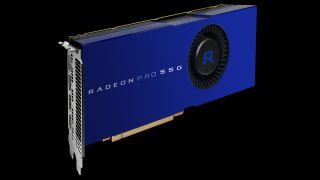AMD's Solid State Graphics sports a whopping 1TB of capacity
More memory means big things for visual computing.

Today's top consumer graphics chips are more than adequate for the needs of gamers, with models sporting 8GB and even 12GB of memory. Professional graphics is an entirely different story, however; Nvidia's top Quadro M6000 has 24GB of GDDR4, while AMD's FirePro S9170 has 32GB GDDR5. That might seem like an obscene amount of memory, but for some workloads even that could prove woefully inadequate.
At SIGGRAPH, AMD announced and demonstrated a working solution that they're calling Radeon Pro SSG—Solid State Graphics—starting at a full 1TB of 'memory' on the board. For the math impaired, that works out to 32 times more capacity than the S9170, or more than an order of magnitude increase. And this isn't just a pipe dream, as AMD announced that they'll be selling the cards in a developer's kit starting in 2017, with a price of $10,000 per card.
What would you actually need that much graphics memory to handle? Not games, at least not any time in the near future, but AMD did demonstrate working prototypes doing 8K video post-production on the SSG. In their demonstration, scrubbing of raw 8K video went from a stuttering 17 fps to over 90 fps with the SSG. Other forms of content creation, scientific and engineering visualization, and processing of large datasets could potentially see equally impressive gains.
What sort of hardware is involved in this solution isn't quite so clear. The name and press release note the use of non-volatile solid state memory, which gives us a good starting point. Rather than having a large SSD on the main system, it appears AMD will integrate 1TB of NAND directly on the Radeon Pro SSG. That will eliminate a lot of latency that would normally be present where the GPU would have to send requests over the PCIe bus to the chipset, and from there to storage—and then the data would need to come back to the GPU over the same route.
One thing AMD isn't talking is bandwidth or throughput for the SSG. We can assume there will be some dedicated volatile memory—probably GDDR5, though it could be HBM or GDDR5X—and the NAND will serve as a local large data store. Beyond that, there's less clarity. NAND storage solutions range from the everyday SATA drives that have maxed out the SATA interface at around 500-600MB/s, to faster PCIe-based solutions including NVMe SSDs that can push 2500MB/s or more. Given the apparent direct integration of NAND onto the Radeon Pro SSG, I'd assume this will be closer to the latter, and potentially it might even be faster.
What could really blow the doors wide open would be the future use of something like Intel and Micron's 3D XPoint Technology, which has been touted as being up to 1000 times faster than NAND, 10 times as dense, and 1000 times more durable. As long as 3D XPoint has to talk to systems over the PCIe bus, it will likely never get anywhere near the 1000 times faster figure…but direct integration onto a motherboard or graphics solution changes things. Not that AMD is likely to use XPoint on the first iteration of their SSG, but Micron is a big player in the non-volatile storage market, and there has already been talk about the ability for XPoint to replace traditional DRAM in some use cases. We might be closer to terabyte-class GPUs than you think.
The biggest gaming news, reviews and hardware deals
Keep up to date with the most important stories and the best deals, as picked by the PC Gamer team.
Jarred's love of computers dates back to the dark ages when his dad brought home a DOS 2.3 PC and he left his C-64 behind. He eventually built his first custom PC in 1990 with a 286 12MHz, only to discover it was already woefully outdated when Wing Commander was released a few months later. He holds a BS in Computer Science from Brigham Young University and has been working as a tech journalist since 2004, writing for AnandTech, Maximum PC, and PC Gamer. From the first S3 Virge '3D decelerators' to today's GPUs, Jarred keeps up with all the latest graphics trends and is the one to ask about game performance.
Most Popular






